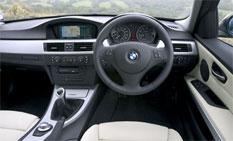Review
An engineer loved the saloon, but wanted more space for family trips, so he spent six months and 600 hours building an estate. He promptly presented the finished product to BMW, which adopted it relatively unchanged.
A version of the Touring has been around since 1971, although the familiar silhouette most drivers know only appeared in 1987.

The new model, which launches in September, retains the familiar appearance but with a number of tweaks designed to keep it competitive in the constant battle for buyers with prestige rivals Audi, Jaguar and Mercedes-Benz.
From the front, the BMW retains the look of the saloon like the 320d Fleet News currently runs on its long-term test.
But move to the rear and the car morphs seamlessly into a load carrier where it once sported a boot.
The transformation works well and includes practical touches such as a split-opening rear tailgate. The rear can be opened normally or just the glass can be lifted for use in small parking spaces.
The tailgate is also cut into the rear bumper which lowers the load height.
Once the boot is open and with the 60/40 split rear seats in place, drivers have 460 litres of luggage space available, an increase of 25 litres over the old model.
Put the seats down, a relatively simple process, and there is 1,385 litres, up 40 litres on the current model. To help make the space more versatile, there are features such as reversible waterproof covers and dividers for the underfloor storage compartment available.

At launch there will be two engine choices – a 2.5-litre petrol and a 2.0-litre diesel, while a 320i four-cylinder and six-cylinder 330i petrol will follow in the autumn, along with a 3.0-litre diesel.
Specs will be ES, SE and a new M Sport alternative.
As standard, the ES gets a six-speed manual gearbox, 16-inch alloy wheels, single-slot CD player, six airbags and run-flat tyres.
SE specification adds an inch to the size of the alloys, automatic air conditioning, cruise control, multi-function steering wheel and rear parking sensors. M Sport offers 18-inch alloy wheels, beefed-up suspension and sports seats. Prices will start at £24,875 for the 320d ES and rise to £33,290 for the 330d M Sport.
Options will include adaptive cruise control and a segment first of Active Steering, pioneered in the 5-series. The system, available as an option on six-cylinder models, varies the steering ratio depending on speed and driver’s actions to give different characteristics.
Corporate sales are expected to account for 55% of Tourings sold, with anticipated full-year demand of 8,500 units.
Among customers drawn to the new model, BMW hopes, will be current 4x4 drivers and MPV-owners.
Behind the wheel
A QUICK check around the rear-end of the 3-series shows that despite it being a relatively compact estate, it is still versatile enough for most needs.
The split rear tailgate is a welcome touch, especially useful if you reverse park near a wall. Clever touches include an automatic release for the tonneau cover when you open the rear glass. The load area isn’t completely square, as the wheel arches intrude just behind the rear seats, but there is still a large amount of space to pack in most items.
The bodyshell is 25% stiffer than the previous model, which is intended to retain the saloon’s handling characteristics. It seems to have done the trick as back-to-back drives of the saloon and estate showed no perceptible difference.
The car handles well in either diesel or petrol guise, despite the weight changes caused by the different engines at the front. A spring across the highlands of Scotland showed both engines in their best light, with the diesel giving the best combination of power and economy. It offers 163bhp, 251lb-ft of torque, hits 62mph in 8.6 seconds and can reach 139mph, with the potential to return 47.9mpg if you treat it nicely. Only the 3.0-litre diesel offers more torque, although for fun higher up the rev range and a better soundtrack, the 2.5-litre petrol is the best choice.
However, the Scottish roads soon showed up a potential downside to choosing based on engine alone.
The type of run-flat tyres available varies and while the high-profile sets fitted to the diesel were almost impossible to tell from a normal set of rubber, the low-profile tyres on the petrol gave a much more jittery ride than non-run-flat equivalents. Where the diesel seemed to soak up bumps and filter out most road imperfections, the petrol model shuddered over them.
The fashion for bigger wheels comes at a price, but it’s best to make sure drivers can live with the ride before they make their mind up.
Driving verdict
The 3-series Touring offers more flexibility with barely any compromise compared to the saloon. The diesel remains the fleet option, but pay close attention to tyre choice.
| Model: | 320d | 325i | ||
| Engine: | 1,995 | 2,497 | ||
| Max power (bhp/rpm): | 163/4,000 | 218/6,500 | ||
| Max torque (lb-ft/rpm): | 251/2,000 | 184/2,750 | ||
| Max speed (mph): | 139 | 151 | ||
| 0-62mph (sec): | 8.6 | 7.2 | ||
| Fuel consumption (mpg): | 47.9 | 32.8 | ||
| CO2 emissions (g/km): | 158 | 208 | ||
| Transmission: | 6-sp manual, | optional 6-sp auto | ||
| On sale: | September | |||
| Prices (OTR): | £24,450-£26,340 | |||
















Login to comment
Comments
No comments have been made yet.